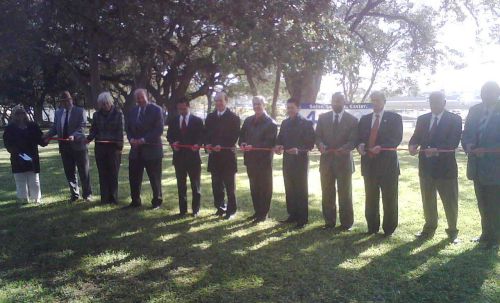Construction and closures History Roads: construction interchange Loop 410 Texas Department of Transportation widening
by Brian
1 comment
Loop 410 is done!

Ribbon-cutting for Loop 410 expansion
For the past 30 years, San Antonians have complained about construction along Loop 410. But no more. As Mayor Julian Castro said during today’s Loop 410 ribbon-cutting ceremony, “the headaches are over!”
The last leg of the nearly $1 billion “410 for SA” project to improve Loop 410 across the northside of San Antonio is just about done with just a few final “punch list” items remaining, so TxDOT and other local officials– including the Mayor, County Judge Nelson Wolff, VIA boss Keith Parker, and city councilman John Clamp– took the opportunity today to celebrate the culmination of 30 years of work that widened Loop 410 from six to 10 lanes from Perrin-Beitel to Culebra and built new interchanges at US 281, San Pedro, I-10, and Bandera Rd. All of these improvements have helped get Loop 410 “ahead of the curve” with regards to traffic and has significantly cut congestion and delays throughout the corridor. And the completion comes just in time: 2009 traffic counts show that Loop 410 has regained its position as the busiest highway in San Antonio with an average of 215,000 vehicles per day between I-10 and US 281.
Getting here has been an adventure. TxDOT began working on plans for Loop 410 back in the early ’80s shortly after work to widen the freeway from four to six lanes was completed. For those of you who were here in the mid ’80s, you may remember front-page newspaper reports about one of the proposals being looked at: double-decking the freeway. Those plans were later refined to the 10 lane freeway that is now in place and the first “preparatory” projects for the I-10 interchange began ca. 1988 with the widening of the Cherry Ridge and Fredericksburg overpasses. A public meeting to discuss the plans for Loop 410 held at Aggie Park in 1995 was the first such meeting I ever attended. Two years later, the first significant widening project expanded the segment from West Ave. to Cherry Ridge. The section between McCullough and US 281 was widened and prepared for the planned 218/410 interchange in 2001 (remember the “stumps” that were put in place there that became the foundations for the elevated ramps?) The section from I-10 west to Callaghan was widened in 2003, followed by the section from West Ave. to Blanco in 2005. On all of those early sections, only eight of the eventual 10 lanes were initially marked to reduce the bottlenecks that remained on each end.
In 2008, the “keystone” section– that being from from Blanco to McCullough– was completed. This provided a continuous widened stretch (except for the I-10 interchange) from North Star Mall all the way over to TxDOT’s offices at Callaghan. Jones-Maltsberger to Broadway and the 410/281 interchange were finished the following year. Work on the I-10 interchange, including widening Loop 410 to eight lanes, was completed in early 2009. The elevated Bandera connectors and work to widen the section from Callaghan to Ingram was completed in mid 2009. Finally, the section from Broadway to Perrin-Beitel is now wrapping-up.
Some folks may wonder why it took so long to complete this project. The answer is simple: funding. With a $1 billion pricetag, the project had to be broken-up into many phases to stay within funding constraints. In fact, the eastern segment– the one being completed now– was not even expected to be funded until later this decade, but local voters approved the Advanced Transportation District (ATD) and its sales tax in 2003, part of which was dedicated to that project and enabled it to receive matching funds from the state far sooner than it otherwise would have.
Another question is what will happen east of Perrin-Beitel. That will be looked at as part of a major investment study of what to do along I-35 North. Major improvements to the Fratt Interchange will be included with that, so nothing will be done east of Perrin-Beitel until those plans are finalized.
Sadly, given the current transportation funding situation in both Washington and Austin, the completion of this project essentially marks the end of a highway construction boom in San Antonio. Over the past seven years or so, over $2 billion worth of highway improvement projects have been completed, largely as a result of the ATD tax, borrowing at the state level, and pass-through agreements with local entities. The only major projects currently in the works are the Wurzbach Parkway and the first phase of the 281/1604 interchange, which unfortunately is facing a possible legal challenge. Beyond that, unless and until the state Legislature figures-out how to solve the transpo funding issues that Texas faces, there won’t likely be any other major projects coming to fruition unless they’re tolled. That’s just the reality of today. And while some people may be relieved that construction zones and their associated headaches may be taking a hiatus, keep in mind that this also means that there is little relief in sight for the remaining congested areas and bottlenecks.